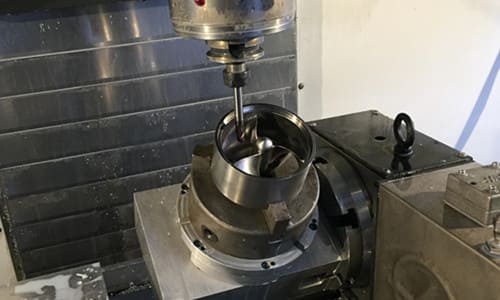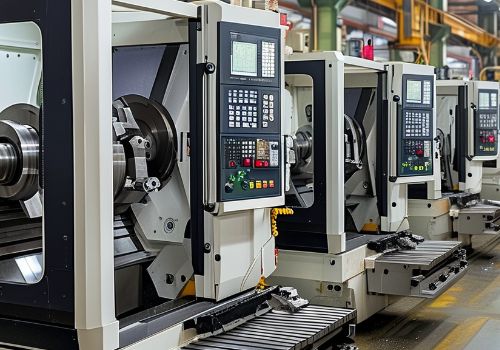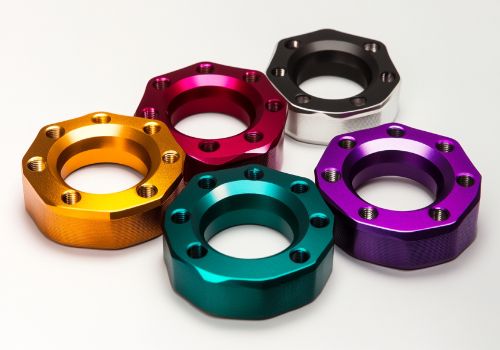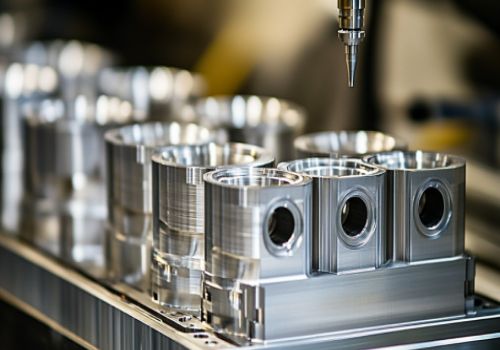The specific strength of titanium alloy products is very high among metal structural materials. Its strength is equivalent to that of steel, but its weight is only 57% of steel. In addition, titanium alloy has the characteristics of small specific gravity, high thermal strength, good thermal stability and corrosion resistance, but titanium alloy materials are difficult to cut and have low processing efficiency. Therefore, how to overcome the difficulty and low efficiency of titanium alloy processing has always been an urgent problem to be solved.
The reason of the difficulty in processing titanium alloy
The thermal conductivity of titanium alloy is small, so the cutting temperature is very high when processing titanium alloy. Under the same conditions, the cutting temperature of processing TC4 is more than twice as high as that of 45 steel, and the heat generated during processing is difficult to release through the workpiece; The specific heat of the alloy is small, and the local temperature rises quickly during processing. Therefore, the temperature of the tool is very high, the tip of the tool wears sharply, and the service life is reduced.
The low modulus of elasticity of titanium alloy makes the processed surface easy to spring back, and the processing spring back of thin-walled parts is more serious. It is easy to cause strong friction between the flank face and the processed surface, which will wear the tool and chip.
Titanium alloys have strong chemical activity and are easy to interact with oxygen, hydrogen and nitrogen at high temperatures, increasing their strength and decreasing plasticity. The oxygen-rich layer formed during heating and forging makes machining difficult.
Principles of cutting titanium alloy materials
In the machining process, the selected tool material, cutting conditions and cutting time will all affect the efficiency and economics of titanium alloy cutting.
1. Choose reasonable tool materials
In view of the properties, processing methods, and processing technical conditions of titanium alloy materials, reasonable selection of tool materials. The tool material should be more commonly used, lower price, good wear resistance, high thermal hardness, and sufficient toughness.
2. Improve cutting conditions
The rigidity of the machine tool-clamp-tool system is better. The clearance of each part of the machine tool should be adjusted well, and the radial runout of the spindle should be small. The clamp work should be firm and rigid enough. The cutting part of the tool should be as short as possible, and the thickness of the cutting edge should be increased as much as possible when the chip capacity is sufficient to improve the strength and rigidity of the tool.
3. Appropriate heat treatment of the processed material
The performance and metallographic structure of titanium alloy materials are changed by heat treatment to achieve the purpose of improving the machinability of materials.
4. Choose a reasonable cutting amount
The cutting speed should be low. Because the cutting speed has a great influence on the temperature of the cutting edge, the higher the cutting speed, the sharp increase in the temperature of the cutting edge. The temperature of the cutting edge directly affects the life of the tool, so choose a suitable cutting speed.
Machining technology
1. Turning
Turning titanium alloy products can easily obtain better surface roughness, and the work hardening is not serious, but the cutting temperature is high and the tool wears quickly. In view of these characteristics, the following measures are mainly taken in terms of tools and cutting parameters:
Tool material: choose YG6, YG8, YG10HT according to the conditions.
Tool geometry parameters: suitable front and rear angles of the tool, tool tip rounding.
Low cutting speed, moderate feed rate, deep cutting depth, and sufficient cooling, the tool tip cannot be higher than the center of the workpiece when turning the outer circle, otherwise it will be easy to stick the tool. When fine turning and turning thin-walled parts, the leading angle of the tool should be large, generally 75-90 degrees.
2. Milling
Milling of titanium alloy products is more difficult than turning, because milling is intermittent cutting and the chips are easy to bond with the cutting edge. When the sticky teeth cut into the workpiece again, the sticky chips are knocked off and a small piece of tool material is taken away. The chipping greatly reduces the durability of the tool.
Milling method: generally adopt down milling.
Tool material: high-speed steel M42.
Down milling is generally not used for machining of alloy steel. Due to the influence of the gap between the screw and nut of the machine tool, during down milling, the milling cutter acts on the workpiece, and the component force in the feed direction is the same as the feed direction, which is easy to make the workpiece table to produce intermittent movement, causing tool crash. For down milling, the cutter teeth hit the crust at the beginning of the cut, causing the cutter to break. However, because up-milling chips vary from thin to thick, the tool is prone to dry friction with the workpiece during the initial cutting, which increases the sticking and chipping of the tool. In order to make titanium alloy milling smoothly, it should be noted that the rake angle should be reduced and the back angle should be increased compared to the general standard milling cutter. The milling speed should be low, try to use sharp tooth milling cutter, avoid using relieving tooth milling cutter.
3. Tapping
Titanium alloy product tapping, because the chip is small, it is easy to bond with the blade and the workpiece, resulting in a large surface roughness value and a large torque. When tapping, improper selection of taps and improper operation can easily cause work hardening, extremely low processing efficiency and sometimes tap breaks.
The jumping-tooth tap must be preferred, and the number of teeth should be less than that of standard taps, generally 2 to 3 teeth. The cutting cone angle should be large, and the taper part is generally 3 to 4 thread lengths. In order to facilitate chip removal, a negative inclination angle can also be ground on the cutting cone. Try to choose short taps to increase the rigidity of the taps. The inverted taper part of the tap should be appropriately enlarged compared to the standard to reduce the friction between the tap and the workpiece.
4. Reaming
The tool wear is not serious during titanium alloy reaming, and cemented carbide and high-speed steel reamers can be used. When using cemented carbide reamer, the rigidity of the process system similar to drilling should be adopted to prevent the reamer from chipping. The main problem of titanium alloy reaming is the poor finish of the reaming. Whetstone narrow width of the reamer blade must be used to prevent the blade from sticking to the hole wall, but sufficient strength must be ensured. Generally, the blade width is 0.1~0.15mm.
The transition between the cutting edge and the calibration part should be a smooth arc, and it should be sharpened in time after being worn, and the size of the arc of each tooth must be the same; if necessary, the inverted taper of the calibration part can be enlarged.
5. Drilling
It is difficult to drill titanium alloys, and the phenomenon of burning tools and broken drills often occurs during the processing. This is mainly caused by several reasons such as poor sharpening of the drill bit, delayed chip removal, poor cooling and poor rigidity of the process system. Therefore, it is necessary to pay attention to reasonable drill sharpening in the drilling of titanium alloys, increase the top angle, reduce the front angle of the outer edge, increase the rear angle of the outer edge, and increase the inverted cone to 2 to 3 times that of the standard drill. Withdraw the tool frequently and remove the chips in time, paying attention to the shape and color of the chips. If the chips appear feathery or the color changes during the drilling process, it indicates that the drill is blunt, and the tool should be changed and sharpened in time.
The drilling jig should be fixed on the worktable, and the guiding face of the drilling jig should be close to the processing surface. Use a short drill bit as much as possible. Another problem worth noting is that when manual feeding is adopted, the drill should not advance or retreat in the hole, otherwise the drill blade will rub against the machined surface, causing work hardening and dulling the drill.
6. Grinding
The common problems in grinding titanium alloy parts are sticky debris causing blockage of the grinding wheel and burns on the surface of the part. The reason is the poor thermal conductivity of the titanium alloy, which causes high temperature in the grinding area, so that the titanium alloy and the abrasive material bond, diffuse and have a strong chemical reaction. Sticky chips and blockage of the grinding wheel lead to a significant decrease in the grinding ratio, burn the surface of the workpiece, and reduce the fatigue strength of the parts. This is more obvious when grinding titanium alloy castings.
To solve this problem, the measures taken are:
Choose a suitable grinding wheel material: green silicon carbide TL. Slightly lower wheel hardness: ZR1.
The cutting of titanium alloy materials must be controlled in terms of tool materials, cutting fluids, and processing parameters in order to improve the overall efficiency of titanium alloy material processing.
As a professional CNC machining manufacturer, DO Machining not only produce metal parts, but plastic and wood parts are also available.
Please visit our CAPABILITIES and what PRODUCTS we did.
CNC machining service is the core business of DO Machining, from protptyes to bulk production, our professional 3/4/5 aixs CNC machining centers, CNC turning equipments, CNC turning-milling equipments, CNC grinding machines etc., are operated by well trained manufacturing engineers to meet the demands from global 1000+ customers in 30+ industries.
CNC Machining can be done starting with blanks produced from standard bar stock or one of DO Machining other manufacturing processes.
Contact us to see how we can provide overall value to your CNC machining needs.










